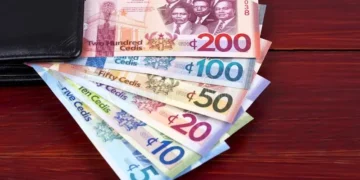At the 9th Forum for China-Africa Cooperation (FOCAC) held in Beijing, China, in September 2024, China pledged 360 billion yuan ($50.7 billion) over three years in credit lines and investments to Africa.
FOCAC brought together leaders from China and Africa under the theme: “Joining Hands to Advance Modernisation and Build a High-Level China-Africa Community with a Shared Future.”
China is the largest bilateral lender to Africa.
In December 2022, Chatham House published that Chinese lenders accounted for 12 per cent of Africa’s private and public external debt, which increased more than fivefold to nearly $700 billion from 2000 to 2020.
The Mo Ibrahim Foundation, in August 2023, said in absolute terms the total debt stock owed by all African governments equates to over $1.8 trillion.
In November 2023, the Institute for Security Studies published that the public debt in Africa surged to a staggering US$1.8 trillion by 2022, representing a 183% increase since 2010.
The ISS said what is “even more concerning is that this rate is nearly 300% higher than Africa’s gross domestic product (GDP) growth rate during the same period. As a result, the debt-to-GDP ratio in many African nations is projected to exceed 60% in 2023, signifying a potential imbalance that will make it difficult for governments to manage their financial resources.”
The ISS noted that China has been a pivotal lender to Africa, extending loans exceeding US$170 billion to 49 African countries and regional institutions between 2000 and 2022.
The African Development Bank Group, in May 2024, estimated that Africa’s total external debt, which stood at $1.12 trillion in 2022, rose to $1.152 trillion by end-2023. The Bank Group computes that Africa will pay out $163 billion just to service debts in 2024, up sharply from $61 billion in 2010.
A 2023 report by the IMF titled Regional Economic Outlook for Africa crunched that China’s share of the total sub-Saharan Africa external public debt rose from less than 2% before 2005 to about 17% – or US$134 billion – in 2021, saying: “This figure is still a relatively small share of the region’s total external debt, which stood at US$790 billion in 2021.”
Africa’s Rising Debt Burden
A recent report by the Africa Export-Import Bank (Afreximbank) titled: ‘State of Play of Debt Burden in Africa 2024 – Debt Dynamics and Mounting Vulnerability,’ noted that debt levels are rising rapidly in African countries. Per the report, Africa’s debt burden has grown “significantly” in the past 15 years.
It said since the 2008 global financial crisis, the aggregate debt-to-GDP ratio of the continent has surged by 39.3 percentage points between 2008 and 2020 and thereafter, declined to 68,6 per cent of GDP in 2023. It then inched up further between 2022 and 2023 by 1.3 percentage points.
The Afreximbank report notes that such debt load was observed 25 years ago and required two rounds of debt relief under the Heavily Indebted Poor Countries (HIPC) Initiative and Multilateral Debt Relief Initiative (MDRI).
What’s Causing the Debt Burden To Rise?
In the view of the bank, “a series of confounded shocks have led to fast-increasing debt levels across the continent.” It names some of these shocks as the 2008 global financial crisis, the COVID-19 pandemic and the war in Ukraine, which, in its opinion, have “exacerbated debt challenges by limiting the region’s growth potential and deteriorating fiscal stance.”
In addition to these, the report said, “The drive to close infrastructure gaps has brought African frontier countries to tap into international markets with the multiplication of Eurobond issuances.”
The Numbers Foretell a Debt Ease
In its outlook, Afreximbank projects that the debt trend “is set to stabilise in 2024 and decline slightly thereafter.” It estimates the debt-to-GDP ratio to decrease by 1.8 percentage points reaching about 66.8 per cent in 2024.
Based on the International Monetary Fund’s forecasts for the outer years (2023 – 2028), the bank computes that the debt in per cent of GDP is set to decline further to 63.5 per cent of GDP in 2028, “thanks to robust growth, higher-than-historical inflation forecasts, and retreating fiscal imbalances.”
The continent’s growth, the report mentioned, is predicted to remain above 4 per cent while the GDP deflator inflation will taper to 7.2 per cent by 2028 as fiscal stance reverts to a surplus of 0.2 per cent of GDP by 2028.
A Chunk of The Debt Is External
The bank’s report observed that African countries have seen a “significant increase” in their external debt since 2008, reaching US$1.2 trillion and accounting for almost 60 per cent of the region’s total public debt stock as of 2023.
In ratio terms, Africa’s external debt load, the report indicates, has increased from 18.8 per cent of GDP in 2008 to 41.6 per cent in 2023.
It said the growing share of external debt increases the risk-to-debt sustainability and the ability to service debt in real terms. “With higher external debt (especially when denominated in foreign currency), developments in debts are tied to currency movements,” the report pointed out.
Which Countries Carry the Heftier Burden?
About 67 per cent of Africa’s total external debt stock is borne by 10 countries, Afreximbank notes in the report. They are: Egypt (14.5 per cent), South Africa (14.3 per cent), Nigeria (8.4 per cent), Morocco (5.9 per cent), Mozambique (5.5 per cent), Angola (5.3 per cent), Kenya (3.7 per cent), Tunisia (3.4 per cent), Sudan (3.1 per cent) and Ghana (3.0 per cent).
The report mentions that in line with the financing needs of infrastructure projects, Africa’s debt has been denominated by long-term debt with the share of that category of debt increasing from 72 per cent to 75 per cent between 2008 and 2003.
Shift From Bilateral and Multilateral Creditors To The Private Sector
Another interesting observation made by the report is that Africa’s debt from private creditors is growing. It points out that over the past decade, there has been a notable shift in the composition of the continent’s creditor base away from traditional Paris Club sources towards commercial and non-Paris Club creditors. “This change reflects changes in the dynamics of global finance and highlights the increasing role played by diverse creditors in the continent’s debt landscape and further reflects the flexibility of private lending despite the relatively higher cost,” explained the report.
In particular, it highlighted that the region has “increasingly” relied on private creditors, and, thus, private debt as a share of GDP increased from 18.8 per cent in 2008 to 41.6 per cent in 2023. “In 2023, private debt constituted more than half of Africa’s external debt,” stressing: “This specifically stood at 54.3 per cent of the total debt, outpacing the contributions of bilateral and multilateral creditors, which accounted for 18.7 per cent and 27.1 per cent, respectively.”
Global Crises Balloon Africa’s Cost of Borrowing
The cost of borrowing has increased markedly for African countries in recent years, notes the report, stating that for most countries, the spread widened in 2023 and continues to expand even in 2024. And this resulted from a conspiracy among a few global crises, explained the report. “With the COVID-19 pandemic, the conflict in Ukraine and the surge in global interest rates having severely dented African economies, most lost access to international capital markets in 2022 and 2023, as borrowing in foreign currency-denominated debt became more expensive.”
For instance, the report cites that Egypt was the “hardest hit on account of delays in reform implementation even though Nigeria’s Eurobond yields improved year-to-date as reforms initiated under the new administration surprised on the upside.”
Borrowing Floodgate Opens Again
After more than a year of inactivity, since the US Fed began its hiking cycle in March 2022, the Eurobond market has been revived with three countries (Cote d’Ivoire, Benin and Kenya) issuing.
In January 2024, Cote d’Ivoire raised US2.6 billion through two bonds with maturities of 9 years at 6.30 per cent and 13 years at 6.85 per cent, the report notes. Additionally, Benin went onto the market with a 14-year bond worth US$750 million at 8.375 per cent in February. Kenya, the biggest economy in East Africa, followed suit and issued a seven-year note of US$1.5 billion at 10.375 per cent. As of the end of June 2023, the outstanding stock for Africa’s sovereign Eurobonds was estimated at US$143 billion (face value) and priced by the market at around US$107 billion. This includes the Zambia (US$3 billion), and Ghana (US$13.2 billion) Eurobonds that are being restructured following defaults, the report added.
Analysis
As China throws more money at Africa with very little or no questions asked, the continent’s debt burden will keep rising. The reopening of the international capital markets to African countries that now have to borrow at more expensive rates due to the ravages done to their economies coupled with the bad ratings given them by the Big Three (Moody’s Investor Services, Standard and Poor’s (S&P), and Fitch Group) portends an even bleaker debt situation for the continent in the medium to long-term. China may very well have an ulterior motive behind these no-conditions loans to Africa, which the West sees as a “Debt Trap” but it seems the African leaders of the beneficiary countries desperately need these loans to bankroll infrastructural development and even fund their lavish and corrupt lifestyles. Whatever the case, it is up to Africans to demand accountability for all these loans taken on their behalf by the people they elected into office.
The Mo Ibrahim Foundation, however, is not convinced that Africa’s debt burden is the heftiest. In an August 2023 article titled: ‘Public debt in Africa: structure is the primary issue, not volume,’ the Foundation argued: “Germany alone has a greater debt stock than this [Africa’s $1.8 trillion] at $2.9 trillion. Even adjusted for GDP, African debt does not stand out as being uniquely high with 49 African countries having lower public debt-to-GDP ratios than the US (122.2%) in 2023. Japan (258.2%) and Greece (166.0%) have higher public debt-to-GDP ratios than any African country. Yet, eight of the nine countries listed by the IMF as being in ‘debt distress’ in 2023 are African. This is because structural factors make debt uniquely burdensome for Africa.”






























